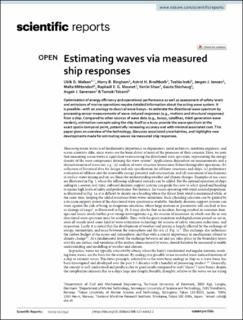| dc.contributor.author | Nielsen, Ulrik Dam | |
| dc.contributor.author | Bingham, Harry B. | |
| dc.contributor.author | Brodtkorb, Astrid H. | |
| dc.contributor.author | Iseki, Toshio | |
| dc.contributor.author | Jensen, Jørgen Juncher | |
| dc.contributor.author | Mittendorf, Malte | |
| dc.contributor.author | Mounet, Raphaël Emile Gilbert | |
| dc.contributor.author | Shao, Yanlin | |
| dc.contributor.author | Storhaug, Gaute | |
| dc.contributor.author | Sørensen, Asgeir Johan | |
| dc.contributor.author | Takami, Tomoki | |
| dc.date.accessioned | 2024-01-26T14:05:09Z | |
| dc.date.available | 2024-01-26T14:05:09Z | |
| dc.date.created | 2023-10-31T10:50:31Z | |
| dc.date.issued | 2023 | |
| dc.identifier.citation | Scientific Reports. 2023, 13 (1), . | en_US |
| dc.identifier.issn | 2045-2322 | |
| dc.identifier.uri | https://hdl.handle.net/11250/3114121 | |
| dc.description.abstract | Optimisation of energy efficiency and operational performance as well as assessment of safety levels and emissions of marine operations require detailed information about the acting wave system. It is possible—with an analogy to classical wave buoys—to estimate the directional wave spectrum by processing sensor measurements of wave-induced responses (e.g., motions and structural responses) from a ship. Compared to other sources of wave data (e.g., buoys, satellites, third-generation wave models), estimation concepts using the ship itself as a buoy provide the wave spectrum at the exact spatio-temporal point, potentially increasing accuracy and with minimal associated cost. This paper gives an overview of the technology, discusses associated uncertainties, and highlights new developments made for estimating waves via measured ship responses. | en_US |
| dc.language.iso | eng | en_US |
| dc.publisher | Nature | en_US |
| dc.rights | Navngivelse 4.0 Internasjonal | * |
| dc.rights.uri | http://creativecommons.org/licenses/by/4.0/deed.no | * |
| dc.title | Estimating waves via measured ship responses | en_US |
| dc.title.alternative | Estimating waves via measured ship responses | en_US |
| dc.type | Peer reviewed | en_US |
| dc.type | Journal article | en_US |
| dc.description.version | publishedVersion | en_US |
| dc.source.pagenumber | 0 | en_US |
| dc.source.volume | 13 | en_US |
| dc.source.journal | Scientific Reports | en_US |
| dc.source.issue | 1 | en_US |
| dc.identifier.doi | 10.1038/s41598-023-44552-2 | |
| dc.identifier.cristin | 2190384 | |
| cristin.ispublished | true | |
| cristin.fulltext | original | |
| cristin.qualitycode | 1 | |

